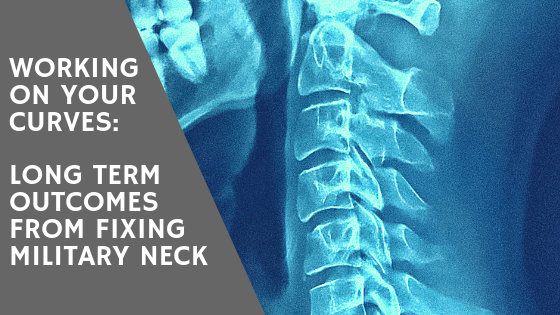Working on Your Curves: Long Term Outcomes From Fixing Military Neck

I’ll admit that I’ve gone back and forth on the importance of cervical curves in my career. When I was in chiropractic school I was adamant about the importance of cervical curves and how the loss of a curve could affect the progression of spinal arthritis.
Then once I was in practice for a few years, I saw that most neck curves wouldn’t really change very much. Despite the fact that it didn’t change, I’d see really great changes and improvements of many of my patients, so I assumed that it is a nice feature, but probably not necessary to resolving a complaint. You can read some of my previous thoughts on cervical curves here:
I Have Military Neck: Now What?
So What Has Changed my Mind?
I still stand by my previous writings and say that having a proper neck curvature is a really good and positive thing, but you can still get really great results with most secondary conditions even if the neck curve doesn’t come back.
However, I have started to come around on the importance of having a proper neck curvature for the health of the human brain and nervous system. So what changed my mind?
Here are three pretty recent studies looking at the impact that cervical curve changes have on dizziness and cerebral blood flow.
The first paper is a study that looked at consecutive patients getting imaging of the arteries going into the brain. Magnetic resonance angiography (MRA) measured the intensity of blood flow with the neck in patients with a straight or military neck pattern. The patients were then placed on a foam orthotic to produce a curve in the neck and a new MRA was taken with the neck in a curved position.

The patients’ MRA scans showed significant improvements in blood flow in the brain when they were lying on the orthotic with an improved cervical curve! The interesting thing is that it’s been known for years that a loss of cervical curve was associated with decreased blood flow in the brain, but there was no evidence showing that improving the curve would change blood flow. Now there is.
While the previous paper is interesting, it’s limited by the small sample size and lack of controls. It was also a proof of concept study, and not one where an intervention was performed and tested to see if it made a difference long term. However, it may help explain why patients can get significant improvement in pain and dizziness.
This next paper features a randomized clinical trial of cervical curve correction along with cervical manual therapies compared to manual therapy alone for cervical dizziness.
The study looked at the results for patients with neck pain and dizziness for short term improvement at 10 weeks, and to see if they sustained improvement at a 1 year follow-up. The results are below.

The chart shows that the patients who were in the cervical curve correction group had significant improvements in head posture and curvature at 10 weeks, but the scores in pain and dizziness were pretty similar for both groups. Both groups got better, but they had similar improvements.
However, the changes at 1 year were impressive, and highlighted in red. While the control group had some regression into neck pain and dizziness, the cervical curve group maintained their symptomatic improvement much better. The mean improvements for both groups all crushed statistical significance, and the mean difference of the Dizziness Handicap Inventory (DHI) was by almost a whopping 30 points. That’s massive!
A similar study was published on patients with persistent neck pain where physical manual therapy was compared to manual therapy and curve correction.
Just like the study involving dizziness, this paper on neck pain showed that both groups had similar improvements in scores on the Neck Pain Disability Index (NDI).

Again, like in the previous study, the 1-year follow-up is where things got interesting. The group that had treatment to improve their cervical curve had a much stronger ability to maintain their improvements in neck pain, while the control group started to return to their original pain scores. This was also largely statistically significant.
Long-Term Improvements Matter
So the big thing that changed my mind is that there is a growing body of work that supports the idea that creating structural changes in your cervical curve seem to help improve long term outcomes.
So while I still believe you can get significant improvement with or without a curve in your neck, your chances of maintaining your results over time seem to increase a LOT when you rehabilitate that curve.
Then you have the possible added benefit of improved blood flow to your brain, and that provides a potential bonus of better brain health.











Leave a Reply
Want to join the discussion?Feel free to contribute!